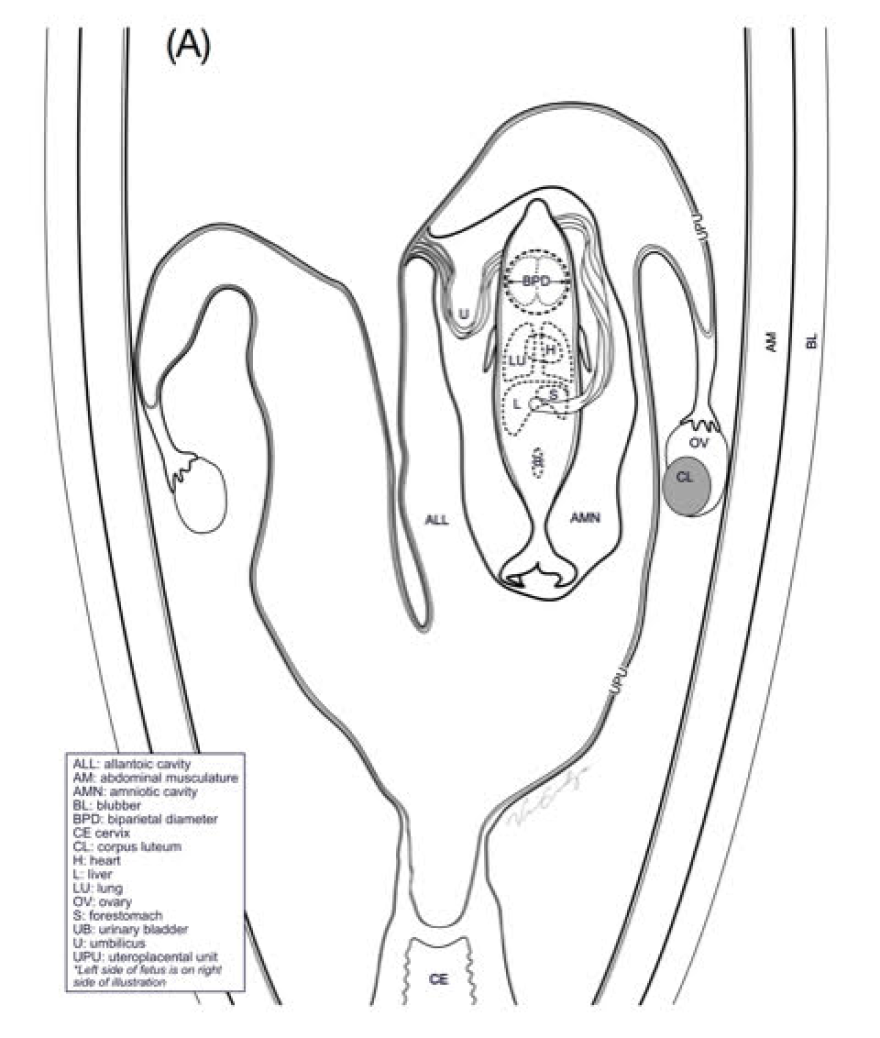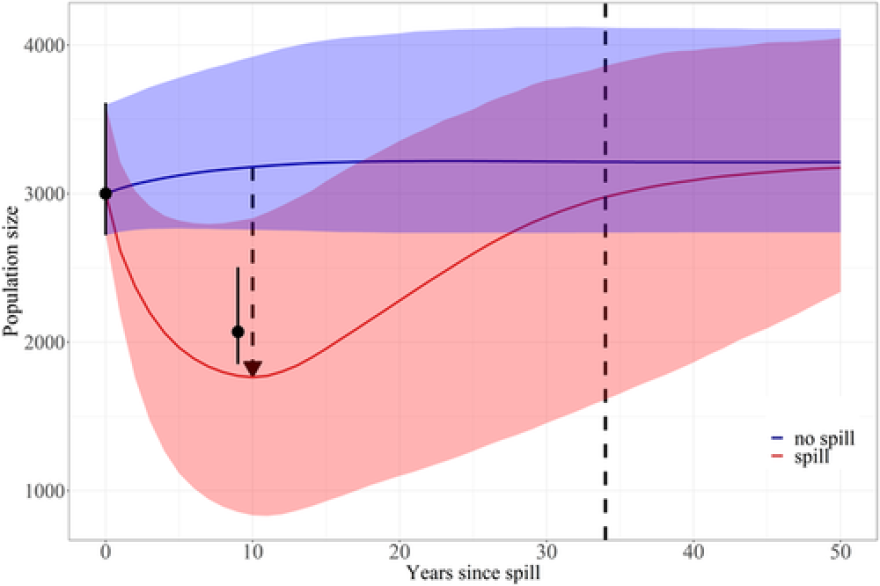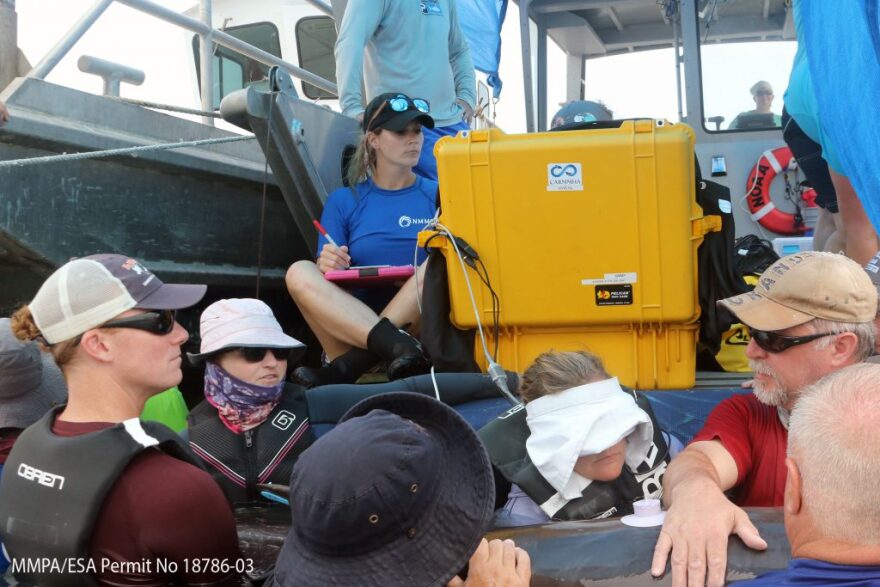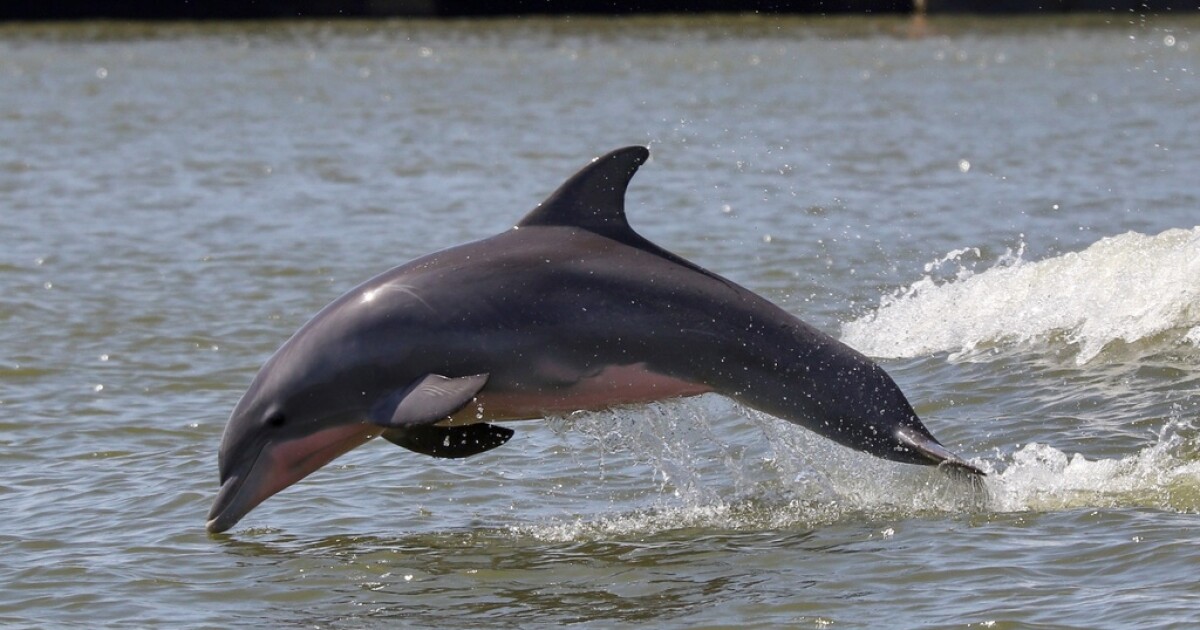[ad_1]
Salty Louisiana wind whips through Forrest Gomez’s hair as her team’s motorboat bumps across the warm waves of Barataria Bay. The inflatable black Zodiak suddenly ker-chunks to a halt beside a small fleet of other research vessels, all outfitted as floating labs.
The scientists from one boat hurl a net into the water. The net trailing behind, they drive in slow circles to capture their study subject: a bottlenose dolphin.
“GO, JUMP NOW,” someone yells. More than sixty marine mammal vets and assistants splash over the sides of the boats into the shoulder-deep water. They lug instruments behind them as they wade toward the dolphin.
Dodging splashes from its muscular tail, Gomez and the crew untangle the animal and position it between them, ready to perform a slew of tests to assess its health.
Wildlife in Barataria Bay, in southeastern Louisiana on the Gulf of Mexico, were some of the hardest hit by the 2010 Deepwater Horizon oil spill. Close to 200 million gallons of oil, an amount that could fill 300 Olympic-sized swimming pools, seeped into the Gulf after a BP drilling rig exploded, making it one of the worst ecological disasters in U.S. history.
Gomez, director of medicine for the National Marine Mammal Foundation, has used floating ultrasound machines to investigate how Barataria Bay dolphin mothers have fared since the spill.
She is clad in chunky goggles and a thick black hood so she can see her screen despite the intense sun. On it: a scan of an unborn baby dolphin. Water makes it easy to get clear images, equivalent to the gel used on pregnant human mothers’ bellies.

National Marine Mammal Foundation
/
Dolphins, along with whales and porpoises, are among the marine mammals known as “Cetacea,” which carry offspring in the womb and give birth to live babies. Research shows that dolphins after the spill had successful pregnancies only about one-fifth of the time — very low compared to the two-thirds in healthy comparison populations. Scientists think oil could have weakened the dolphins’ stress responses, immune systems and lungs, making mothers more vulnerable to sickness — and thus to losing their babies.
“It’s kind of a perfect storm,” Gomez said.
Reproductive failure is just one of the serious health impacts the dolphins continue to face a full 12 years since the oil spill. Yet the money set aside for the disaster — a record $18.5 billion, including a $5.5 billion Clean Water Act violation fine — has led to unprecedented new tools and investment in science.
Long-term, focused research meant that scientists like Gomez were able to define the conditions of a normal dolphin pregnancy. After more than a decade of refinement, her full-body ultrasound scans now take only 10 minutes.

National Marine Mammal Foundation
/
Researchers hope to apply this expertise to other marine mammal species; reproduction is important for understanding population growth and decline. Such knowledge can inform conservation decisions or planning for crises, Gomez said.
“There is no doubt that Deepwater Horizon expedited a lot of these techniques,” Gomez said.

Veronica Cendejas
/
National Marine Mammal Foundation
All this new science could help us respond to threats yet to come, from declining water quality to worsening red tides, researchers say. Since dolphins will likely experience the negative effects of polluted water first, what happens to them might happen to humans down the road.
“Dolphins are sentinels of ecosystem health,” said Randy Wells, director of the Chicago Zoological Society’s Sarasota Dolphin Research Program, who has studied dolphins for more than 50 years.
The question is whether humanity will keep investing.
Gauging the damage
Bottlenose dolphins are just one of the more than 30 different dolphin species around the world. They can grow up to 13 feet, or about as long as a Volkswagen Beetle. In populations that have been studied long-term, females have been known to live up to 67 years, and males up to 52 years, Wells said.
They demonstrate high levels of intelligence and problem-solving. Bottlenose dolphins also have complex social interactions, and many live in resident communities, interacting with the same individuals over the course of their lives. Even facing oil spills, hurricanes, or other threats to their environments, they tend to stay in their same home ranges.

National Marine Mammal Foundation
/
Len Thomas once joined the team studying these dolphins in Barataria Bay. But after a “pissed-off stingray” sent the ecological statistician from Scotland’s University of St. Andrews speeding back to dry land with a barb sticking out of his foot, he decided to crunch dolphin data from the safety of Zoom calls.
Baseline data on dolphin populations was scant before the spill, leaving researchers with little to analyze. But in its aftermath, scientists had to quantify the oil’s impact so the government could determine how much funding and restoration was necessary.
It was a complicated process. A simple death count would have underestimated the damage, as it wouldn’t account for future generations that would have been born if there hadn’t been a spill, said researcher Ryan Takeshita, who worked on the damage assessment.
“We didn’t just want to think about the dead dolphins,” said Takeshita, who now serves as deputy director of conservation medicine at the National Marine Mammal Foundation.
And while statistician Thomas predicted that it would take about 35 years for the dolphins to recover to 95% of their original population, he wanted more clarity on the spill’s impact.
Using data collected from the health assessments, Thomas came up with a population measurement that offers a more accurate picture of dolphin recovery: lost cetacean years.
“Across all individuals that could have been there, it’s the difference in the number of years they did experience from the number of years they could have experienced,” Thomas explained.
The final number from his model: in addition to its more obvious damage, the spill eliminated 31,000 cetacean years.
“We now have something that can apply to basically any cetacean species,” he said. “The modeling framework is there.”
Going forward, Thomas hopes to see more baseline data collected so that marine mammal scientists can reference it if another disaster happens.

Beat of the bottlenose
Once scientists are in the water with bottlenoses, “it’s really like a well-organized circus,” said Barb Linnehan, deputy director of animal health and welfare for the National Marine Mammal Foundation. The team works simultaneously to collect their data and let dolphins go as quickly as possible.
For Linnehan, a cardiac vet, this meant honing new techniques for listening to dolphins’ pulsing heartbeats. Prior to oil spill investigations, wild dolphins’ hearts had never been studied. There were no agreed-upon standards for monitoring the hearts.
“That foundation just hadn’t been laid yet,” Linnehan said.
After months of practice, Linnehan’s team hammered out a five-minute method. Vets reached between a dolphin’s front fins and tilted it onto its side to get the best angle. Then, they used an extra-long waterproof stethoscope to listen to the dolphin’s heartbeat, or grabbed an ultrasound wand connected to a floating yellow ECG machine to take internal pictures.

National Marine Mammal Foundation
/
The team’s research revealed that Barataria Bay dolphin hearts are unusual. Compared with those of healthy wild dolphins in Sarasota Bay, the walls of their ventricles — the part of the heart that pumps blood to the rest of the body — were thinner than normal, which may be linked to oil pollution, Linnehan said.
Perfecting the techniques and applying them to other populations, Linnehan’s team found another surprising fact: a majority of the dolphins studied had harmless heart murmurs.
Dolphins have big, muscular hearts that pump blood extremely fast. Sometimes, this causes an extra sound, or murmur, in their heartbeat, a phenomenon also seen in other athletic mammals like sled dogs, race horses and even human marathon runners.
Knowing these murmurs are normal is important to both traditional dolphin vets and those studying future marine crises because it may help them prioritize more serious concerns, Linnehan said.
In retrospect, Linnehan said, scientists should have been studying wild dolphins’ hearts all along.
“It’s unfortunate that it takes huge environmental disasters like that to get people to actually notice and care,” she said. “But then we have to capitalize on that momentum.”
Swimming into uncertainty
The benefits of many of these innovations are already clear.
For one, Thomas’ models are already being used to measure potential effects from the Mid-Barataria Sediment Diversion, a project meant to restore erosion the oil spill caused. Some scientists think it will ultimately decrease the salinity, or saltiness, of the water.
Thomas predicts this low salinity will be “absolutely catastrophic” for the dolphins in Barataria Bay.
“This makes Deepwater Horizon seem like a walk in the park,” Thomas said. “It’s going to effectively destroy the population if it carries on year after year.”
While the initial restoration funding from Deepwater Horizon has been depleted, researchers stress the importance of investing in such science so research like this can continue.
Beyond following-up on the post-spill health of dolphins, scientists like Gomez hope to pursue other crucial projects, like ramping up rehabilitation and rescue efforts for stranded animals.
“The funding was so impactful, but the story isn’t over,” Gomez said.
According to Wells, Florida is lucky it hasn’t experienced devastating oil spill impacts comparable to Louisiana given the sheer amount of drilling on the Gulf coast.
“Trusting that nothing is going to go wrong is a fool’s errand,” Wells said.
Climate change presents another water quality threat, as pathogens survive longer in hotter water. Nutrients from agriculture, septic tanks and sewage infrastructure not designed to handle Florida’s fast-growing population continue to exacerbate red tides, killing dolphins and the prey they depend on. Long-lasting pollutants and trash crowd waterways.
“Where controls are not in place to control the pollution that’s going into the water, it has pushed ecosystems beyond the tipping point,” Wells said. “We need to give ecosystems a chance to bounce back.”
While dolphins will likely be on the front lines of these threats, Wells said, humans could feel some of the same effects. Dolphins and humans have common interests: we are mammals that depend on clean water for life.
This story is part of the UF College of Journalism and Communications’ series WATERSHED, an investigation into statewide water quality marking the 50th anniversary of the Clean Water Act, supported by the Pulitzer Center’s nationwide Connected Coastlines reporting initiative.
[ad_2]
Source link

